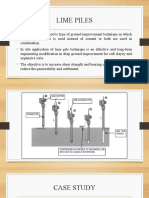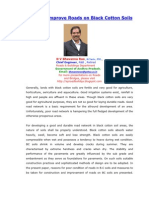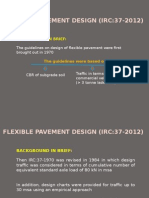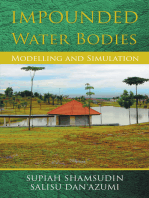Methods of Soil and Base Stabilization
Uploaded by
Sunil BoseMethods of Soil and Base Stabilization
Uploaded by
Sunil BoseSOIL,SUBBASE,BASE
STABILIZATION METHODS
AND DESIGN OF FLEXIBLE
PAVEMENTS
DR SUNIL BOSE
FORMER , HEAD FLEXIBLE PAVEMENTS DIVISION,
CENTRAL ROAD RESEARCH INSTITUTE
NEW DELHI
(sunilb.crri@gmail.com, +919810376409)
&
BRIG Y.S. SIROHI
M/S ALCHEMIST TOUCHNOLOGY LTD
WHY SHIFT TO STABILIZATION
Conventional construction material like
aggregates is becoming progressively scarce on
account of environmental concerns as well as
legal restrictions on quarrying while the
construction activity has expanded phenomenally.
This has shifted focus from large scale use of
conventional aggregates to use of local, recycled
and engineered marginal aggregates in
construction.
SOIL STABILIZATION
THE TERM SOIL STABILIZATION ITSELF IMPLIES
THAT THE SOIL IS UNSTABLE.
IMPLYING THAT IT IS UNSUITABLE FOR TAKING
THE LOAD, FAILS DUE TO SHEAR.
SHOWS EXCESSIVE SETTLEMENT CAN BE
CONSIDERED AS EXCESSIVE SETTLEMENT
NECESSITY OF SOIL STABILIZATION
DIFFERENT METHODS OF SOIL
STABILIZATION
MECHANICAL STABILIZATION
Mechanical soil stabilization means
stabilization without adding and chemical
or admixtures.
It involves addition or removal of soil
component
Index properties of soil , gap graded soils
are poor bases for compaction
ADVANTAGES OF MECHANICAL
STABILIZATION
1) ECONOMICAL
2) SIMPLE TO CARRY OUT
3) RAPID, CONSTRUCTION CAN BE IMMEDIATELY
STARTED
DISADVANTAGES OF MECHANICAL
STABILIZATION
1) EFFECTIVE ONLY UPTO A CERTAIN EXTENT
2) NOT SUITABLE FOR ALL SOIL TYPES
3) REQUIRES SPECIAL EQUIPMENT
SOIL LIME STABILIZATION
THIS TYPE OF STABILIZATION IS SPECIALLY
EFFECTIVE IN CASE OF PLASTIC CLAY
SLAKED LIME IS FOUND TO BE VERY EFFECTIVE IN
SUCH SOILS
THIS METHOD IS GENERALLY USED FOR BASES
AND SUBGRADES
LIME IS EITHER USED ALONE OR IN COMBINATION
WITH FLYASH OR CEMENT
THE PERCENTAGE OF LIME REQUIRED FOR
COARSE GRAINED SOILS IS 2% TO 8% & 5%
TO 10% FOR PLASTIC SOILS
ADVANTAGES OF LIME STABILIZATION
1) CHEAP
2) EASY AVAILABILITY OF LIME
3) EXPERT SUPERVISION IS NOT NEEDED
DISADVANTAGES OF LIME
STABILIZATION
1) NO DRASTIC ALTERATIONS IN PROPERTIES
2) SUITABLE ONLY FOR PLASTIC CLAYS
CEMENT STABILIZATION:
THE SOIL STABILIZATION WITH CEMENT IS
KNOWN AS SOIL STABILIZATION
THE CEMENT ACTION IS THE RESULT OF
CHEMICAL WITH SILICON PRESENT IN SOIL
PRESENT IN SOIL DURING THE PROCESS OF
HYDRATION. THIS HAPPENS IN NON-COHESIVE
AND COARSE GRAINED SOIL
VERY FEW PARTICLES FOR CEMENT BONDING IN
CASE OF FINE GRAINED COHESIVE SOIL
ADVANTAGES OF CEMENT
STABILIZATION
1) LARGE INCREASE IN STRENGTH
2) VERY USEFUL FOR LOOSE SOIL AND NON-
COHESIVE SOIL
3) PERMANENT SOLUTION
DISADVANTAGES OF CEMENT
STABILIZATION
1)COSTLY
2)COMPLICATED PROCEDURE
3)NOT USEFUL FOR CLAYS, ORGANIC SOILS AND
EXPANSIVE SOILS
4)SHRINKAGE CRACKING
CLASSIFICATION OF BITUMEN
STABILIZATION
ADVANTAGES OF BITUMEN
STABILIZATION
1) DURABLE FOR A YEARS
2) CHEAPER THAN SOIL CEMENT
3) VERY USEFUL FOR ROAD, SUBGRADES AND
WATER PROOF STRUCTURES
DISADVANTAGES OF BITUMEN
STABILIZATION
1) EFFECTIVE FOR ONLY SOME SOIL TYPES
2) NOT USEFUL FOR FOUNDATION
3) WATER PROOFING RATHER THAN STRENGTH
ENHANCEMENT IS ACHIEVED
FLYASH STABILIZATION :
FLYASH IS WATER MATERIAL FORMED DUE OF
MINERAL COAL
POSSES A DIFFICULTY FOR DISPOSAL
WHEN USED IN SOIL STABILIZATION ITS ACTION IS
TWOFOLD:
1) IT FORMS FILLER OR POZOLANA MATERIAL
2) IT HYDRATES FORMING CEMENT LIKE GEL
FLYASH BY ITSELF IS RARELY USED IN SOIL
STABILIZATION
ADVANTAGES OF FLYASH STABILIZATION
1) ECOFRIENDLY AS IT HELPS IN RECYCLING
OF FLYASH
2) SIMPLE
3) CHEAP
4) RAPID
DISADVANTAGES OF FLYASH
STABILIZATION
1)CEMENT BE USED AS STAND ALONE METHOD
2) ENHANCEMENT IS NOT SUBSTANTIAL
DURABILITY TEST
ASTM D 559
5 HRS IN WATER, DRYING AT 70 DEG C FOR 41
HRS, 12 CYCLES, 18 TO 20 STROKES WITH
BRUSH, NEXT REWEIGH THE SAMPLES AND
DETERMINE THE WEIGHT CHANGE.
ALTERNATE
FREEZE /THAW
-24 DEG C FOR 24 HRS
THAWING AT 21 DEG C FOR 24 HRS
12 CYCLES AND REWEIGH SAMPLES
LIMITS
GRANULAR SOILS 4%, COHESION SOIL 7%
BASE < 20%, SUBBASE < 30, SHOULDERS < 30 %
IRC 37 (2012) for flexible pavements include flexible
pavements with Bituminous surfacing over:
(i) Granular base and subbase
ii) Cementitious bases and subbases with a crack
relief layer of aggregate interlayer below the
bituminous surfacing
(iii) Cementitious bases and subbases with SAMI
between bituminous surfacing and the
Cementitious base layer for retarding the reflection
cracks into the bituminous layer
(iv) Reclaimed Asphalt Pavement (RAP) with or without
addition of fresh aggregates treated with foamed
bitumen/ bitumen emulsion.
(v) Use of deep strength long life bituminous
pavement
Bituminous layer
Base layer (granular-unbound/bound)
subbase layer(granular-unbound/bound)
subgrade
Base layer (granular-unbound/bound)
Base layer (granular-
unbound/bound/recycled RAP/HIR/FA/EA
Bituminous layer
A Cross section of a
flexible/bituminous pavement
Base
1. Granular(WMM)
2. Cement treated
3. Bitumen-emulsion treated
4. Foamed bitumen treated
5. HIR/CIR
Some commercially available stabilisers
/cementitious materials/ bitumen-
emulsion make marginal aggregates
suitable for bases
Pavement design model
The basic approach is same as that of IRC:37-
2001
The thrust is to
1.Limit rutting in bituminous layer
2.Limit rutting in non-bituminous layers
3.Limit cracking at the top and bottom of
bit. Layer
4. Limit cracking in the cemented layer
Elastic layered approach pavement model
v
E
1
,h
1
,
1
E
2
,h
2
,
2
E
3
,h
3
=,
3
z
A three layer flexible pavement
Granular layer
Subgrade
t
BC layer
Dual wheel load
Rut resistant
BC and DBM II
Fatigue resistant
layer DBM
Granular layers
DBM II
Subgrade
DBM I
Pavement life is increased at least twice
by mix design alone.Less thickness for
same design life
(a) (b)
Figure Cracks at bottom(a) and top(b)
BT
BT
Granular base
Granular base
CRITERIA 1
Min 7 day UCS of cementitious base = 4.5 to 7 Mpa
(IRC:89- 2010)
E(Mpa)= 1000 UCS
Min 7 day UCS values for the cemented subbase : 1.5
MPa to 3.0 Mpa(IRC:89-2010)
Initial modulus of cemented GSB: 2000 MPa to 4000
Mpa
Low strength cementitious material may not retain the
initial modulus because of cracks due to shrinkage,
construction traffic as well as wetting and drying
A lower modulus of 600 MPa may be adopted for
design(SA)
Fatigue of cemented layer(Austroads)
12
804 . 0
]
) 191 / 113000 (
[
E
RF N
RF=1 for heavy commercial vehicles>1500
Valid for E in the range 2000-10000 Mpa
Recommended RF=2 for truck traffic less
than 1500 per day
Fatigue Relationship for various types of cemented materials
40
60
80
100
120
140
160
180
200
100000 1000000 10000000 100000000 1000000000 10000000000
Number of Load Repetitions
A
p
p
l
i
e
d
S
t
r
a
i
n
(
m
i
c
r
o
s
t
r
a
i
n
)
Appl i ed Strai n (mi crostrai n) ()
A SAMI of CRMB/PMB must be provided
over the cemented layer to delay the cracks
propagating to the bituminous layer.
A granular of thickness 75 to 150mm
sandwiched between the bituminous layer
and cemented layer may extend the fatigue
life of the bituminous layer by about three
to five times than without it
Cracking of cemented base is the end of
design life of the pavement
Use of cemented base to obtain
cost effective pavements
(SA/AUSTRALIA/US)
75mm to 150mm of aggregate layer
increases the fracture life of the bit.top
by 3 to 5 times. Neglect residual life of
asphalt layer if its thickness<
175mm(AUSTROADS)
BC/DBM layer
Aggregate
Layer
Cementitious
layer
Gran.subbase
CRITERIA 2
Fatigue fracture life as per the IRC:37
( For 80% reliability)
N
f
=2.21 x 10
-4
x (1/
t
)
3.89
x (1/E)
0.854
E values are given in the draft
One has freedom to select a binder
depending upon experience
Rutting of subgrade has not been a
problem as per current IRC:37
Fatigue equations for 90% reliability
N
f
= 0.711 * 10
-04
x [1/
t
]
3.89
* [1/E]
0.854
Effect of bitumen content and air void
N
f
= 0.5161 * C*10
-04
x [1/
t
]
3.89
* [1/E]
0.854
Where
C= 10
M
, .. (AI,Shell)
V
a
=air void and V
b
=volume of bitumen,
N
f
= fatigue life,
t
= maximum tensile strain at the
bottom of DBM
CRITERIA 3
Rutting in flexible pavement
If elastic vertical subgrade strain, z is
limited, z gets limited in all layers
Good correlation between rutting on
surface and v p/
z
= K x (N)
c
p= Plastic deformation
Such an approach was adopted by
other countries also
MEPDG uses another approach
5337 . 4 8
) / 1 ( 10 1656 . 4
z
Nr
Rutting equation for 80%
and 90% reliability
N= 1.41x 10
-8
x [1/
v
]
4.5337
Above Eqs. guards against rutting
in granular layer and the subgrade
only
RESULTS OF IIT PAV PROGRAM
250 250 250 250 250 250 250
80
90
110
130
90
110
130
100
100
100
100
100
100
100
60
50
50
30
40
50
50
40
50
50
0
100
200
300
400
500
600
700
2-5 6-10 11-20 21-30 31-50 51-100 101-150
P
a
v
e
m
e
n
t
T
h
i
c
k
n
e
s
s
i
n
m
m
Traffic in msa
CBR 5%
CT Subbase-D+F(E=600 Mpa) CT Base(E=5000 Mpa) Aggregate Layer (E=450 Mpa) DBM SDBC(upto 5msa)/BC
Bituminous pavements with cemented base and cemented
subbase having 100mm of aggregate interlayer for crack
relief. Upper 100mm of the cemented subbase is the
drainage layer(BC and DBM at OBC)
1. Low strength base develops only fine
cracks and the reflected cracks in BT also
would be fine and impermeable to water
(Trial sections in TN)
2. Higher strength cemented layers may
develop wide cracks which may reflect to
the bituminous layer(PCA)
3. Cemented bases performed well in tial
sections (i)Krishnagiri-Topurghat Road
project(Tamilnadu) FWD and BB deflection
(ii) Ahmedabad-Udaipur(NH8) (iii)
Jamnagar refinery in Gujarat
(iv) Ahmedabad-Baroda expressway
(v) Achad-Manor in Maharashtra
(v) Chitradurga haul road in Karnataka(FWD)
(vi) Durbal-Hanjik Road in Srinagar
(viii) Reasi-Pauni Road in Jammu(Dist:Katra)
Cement content around 4 to 6%
Rotavator
Zipper
Milling and Mixing Writgen
FULLY MECHANISED STABILIZATION MACHINE- STEHR
ADVANCEMENT MIXING/MILLING
STABILIZATION PROJECTS
IN INDIA
SPECIAL EQUIPMENTS USED FOR
STABILIZATION PROJECTS IN INDIA
STEHR EQUIPMENT
TECHNICAL DATA-STEHR
Integrated, dustfree stabilizer with John Deere Engine:
Working width: 2400 mm
Working depth: 0-400 mm
Total length: 12 m
Total width: 2,80 m
Total height: 3,15 m
Total weight: 22800 kg
Recycled Area: Max 700 sq mtr/hr ( upto depth 400
mm)
EXECUTION STEHR -1
1- SPREADING AND LEVELLING
2- MIXING
3- LAYING
4- STABILIZED LAYER
BEFORE COMPACTION
National Highway Application in India
GSB 200mm
Sub grade 300mm
WMM 250mm
BC - 40mm
DBM - 60mm
GSB 100mm
Embankment Local Soil (CBR 12)
Soil + 4% RBI 225mm (Borrowed Soil)
SDBC - 40mm
20 MSA, 15 % CBR
RBI Method = 365 mm (450mm IRC 37)
Conventional= 550 mm
IRC 37 30 msa, 3% CBR
RBI Method = 500 mm
Conventional= 810 mm
CONSTRUCTION USING THE
WMM PLANT
National Highway Application in India
CONSTRUCTION USING
ROTORVATOR
VIEW OF MACHINE PARTS RBI BAGS -4
S. No State Road Name Length of Road
in Meters
Remarks
5 Jammu & Srinagar Rawalpura Peerbagh
Bund road Via Alamdar
Colony
2000 PWD Srinagar
6 Rajasthan Suratgarh Army Cant
Road
1200 Indian Army
7 Himachal Pradesh NH-22, Km 166/860 to
Km 166/970, Dadu Phagi
Road
110 NH Division, HP
PWD
8 Rajasthan Affordable Group
Housing Society
180 Internal Road
9 Uttar Pradesh IRC Annual Session in
Smirati Upvan
500 Internal Road
PWD Jammu--Pic no 1
25% 10 MM Aggregate+25%20
MM Aggregate+50% Stone
Dust+4% RBI Grade 81125 MM
Suratgarh Rajasthan
Pic no 2
PMC 20 MM
70% Soil+30% Aggregate+4% RBI Grade 81150 MM
GSB100 MM
Affordable in Rajasthan--Pic no 4
SDBC-25 MM
75% Soil+25% 20 MM Aggregate+4%
RBI Grade 81150 MM
Dadu Phagi Road in HP--Pic no 3
BC-40 MM
25% 10 MM Aggregate+25% 20 MM
Aggregate+50% Stone Dust+5% RBI Grade 81
GSB Existing
Subgrade Existing
STABILIZED LAYER AS SUB BASE UNDER
PQC EXPRESSWAY
Bidar -Karnataka
Cold-In-Plant Recycling
Cold-In-Situ Recycling
Cold Recycling
RECYCLER MACHINE
IN-PLANT STABILIZATION/RECYCLING
IN-SITU-STABILIZATION/RECYCLING
CONDITION BEFORE RECYCLING
Existing Pavement Condition Before Recycling
EXISTING PAVEMENT CRUST
Existing Pavement Crust Before Recycling
IN-SITU-RECYCLING WITH STABILIZER
Milling & mixing with Stabilizer & Water using IN-Situ-
Recycler
COMPACTION
Compacting Recycled Layer
AFTER ROAD MARKING
Cold Recycling Stretch after two months
EXISTING PAVEMENT CONDITION
Poor Pavement Condition
MILLING OF EXISTING PAVEMENT
Milling is in progress with Asphalt Zipper
MIXING STABILIZER
COMPACTION OF MIXED MATERIAL
Compaction in Progress-Initial Compaction using Tandem
Roller & Final Compaction using Pneumatic Tired Roller
Initial Compaction Final Compaction
COMPACTED STABILIZED
RECYCLED SURFACE
Compacted Surface of Stabilized Recycled Layer
SDBC IN PROGRESS
Primed Recycled Surface
You might also like
- Chapter 3 Problems in Construction of High EmbankementsNo ratings yetChapter 3 Problems in Construction of High Embankements67 pages
- Unit V Evaluation and Maintenance of Pavements 8No ratings yetUnit V Evaluation and Maintenance of Pavements 87 pages
- Transportation Engineering-Ii: Flexible Pavement DesignNo ratings yetTransportation Engineering-Ii: Flexible Pavement Design59 pages
- SS Seehra Black Cotton Soil Areas FinalNo ratings yetSS Seehra Black Cotton Soil Areas Final28 pages
- Asphalt Institute Method FOR Flexible Pavement Design: Dr. Padma Bahadur ShahiNo ratings yetAsphalt Institute Method FOR Flexible Pavement Design: Dr. Padma Bahadur Shahi30 pages
- Difference Between Flexible & Rigid Pavements100% (2)Difference Between Flexible & Rigid Pavements2 pages
- CSE312-Topic 3-Pavement Material Characterization 2022No ratings yetCSE312-Topic 3-Pavement Material Characterization 2022121 pages
- Presentation On Reinforced Earth & Reinforced Earth StructuresNo ratings yetPresentation On Reinforced Earth & Reinforced Earth Structures19 pages
- Construction Steps of Flexible PavermentNo ratings yetConstruction Steps of Flexible Paverment6 pages
- Causeways: Figure 1 Causeways With Low Volume Flow and in FloodNo ratings yetCauseways: Figure 1 Causeways With Low Volume Flow and in Flood14 pages
- Bituminous Material and Pavement DesignNo ratings yetBituminous Material and Pavement Design35 pages
- New Techniques of Erosion Controls On Hill Roads (A V Shinde)50% (2)New Techniques of Erosion Controls On Hill Roads (A V Shinde)23 pages
- Highway Construction - I: Road Construction, Pavement Layers Conventional & Alternative MaterialsNo ratings yetHighway Construction - I: Road Construction, Pavement Layers Conventional & Alternative Materials61 pages
- 4.2 Materials - Subgrade (Modulus and CBR)No ratings yet4.2 Materials - Subgrade (Modulus and CBR)13 pages
- Steps To Improve Roads On Black Cotton SoilsNo ratings yetSteps To Improve Roads On Black Cotton Soils13 pages
- Construction Details and Guide Specifications For Interlocking Concrete PavementNo ratings yetConstruction Details and Guide Specifications For Interlocking Concrete Pavement16 pages
- Design For Widening To Two Lane: Permissible Micro Strain (90 % Reliability) 208No ratings yetDesign For Widening To Two Lane: Permissible Micro Strain (90 % Reliability) 2083 pages
- Design and Construction of Block Pavements PDF100% (1)Design and Construction of Block Pavements PDF68 pages
- PowerPoint Presentation ROAD PAVEMENT FAILURE (COREN ASSEMBLY) REVISED FINAL100% (5)PowerPoint Presentation ROAD PAVEMENT FAILURE (COREN ASSEMBLY) REVISED FINAL110 pages
- New Cement Developed by Blue World Crete: Leave Your CommentNo ratings yetNew Cement Developed by Blue World Crete: Leave Your Comment1 page
- MODIFIED BITUMEN-Product, Purpose, Advantages Including Global and Indian ScenarioNo ratings yetMODIFIED BITUMEN-Product, Purpose, Advantages Including Global and Indian Scenario59 pages
- Ashoka Aggregate Gradations For CRMB MixNo ratings yetAshoka Aggregate Gradations For CRMB Mix2 pages
- Ashoka Aggregate Gradations For CRMB MixNo ratings yetAshoka Aggregate Gradations For CRMB Mix2 pages
- Final BC Grade 2 With VG 40 Honeywell Titan Polymer 56 HMP 1 Lime and 0.8 PolymerNo ratings yetFinal BC Grade 2 With VG 40 Honeywell Titan Polymer 56 HMP 1 Lime and 0.8 Polymer15 pages
- IRC Draft Specification For Cold Milling 14 April 2011No ratings yetIRC Draft Specification For Cold Milling 14 April 20113 pages
- Optimization of Spheroidized Annealing Process Parameters On AISI 10B21 Steel Wire Using Taguchi ApproachNo ratings yetOptimization of Spheroidized Annealing Process Parameters On AISI 10B21 Steel Wire Using Taguchi Approach4 pages
- Mike Holt's Illustrated Guide Onal Electrical Code, 2020 NEC 355No ratings yetMike Holt's Illustrated Guide Onal Electrical Code, 2020 NEC 3551 page
- Review of Literature: (Citation Leo13 /L 1033) (CITATION Jon15 /L 1033)No ratings yetReview of Literature: (Citation Leo13 /L 1033) (CITATION Jon15 /L 1033)5 pages
- Analytical Prediction of Seismic Behaviour For Concentrically-Braced Steel SystemsNo ratings yetAnalytical Prediction of Seismic Behaviour For Concentrically-Braced Steel Systems16 pages
- Structural Systems and Stress Direction: Lecture # 5No ratings yetStructural Systems and Stress Direction: Lecture # 512 pages
- Preparatory Works: 5.1 Approved Shop Drawing, Method Statement, Material and SampleNo ratings yetPreparatory Works: 5.1 Approved Shop Drawing, Method Statement, Material and Sample6 pages
- Fosroc Cebex Cable Grout: Pre-Bagged, Non-Shrink Cementitious Grout Admixture For Post Tensioned CablesNo ratings yetFosroc Cebex Cable Grout: Pre-Bagged, Non-Shrink Cementitious Grout Admixture For Post Tensioned Cables3 pages
- CPTA-CCJV-CON-MST-0004 Method Statement For Concrete Work100% (1)CPTA-CCJV-CON-MST-0004 Method Statement For Concrete Work23 pages
- 3 Bending Stresses & Shear Stresses in Beams PDFNo ratings yet3 Bending Stresses & Shear Stresses in Beams PDF107 pages
- Lab Report #3: Standard Proctor Test For SoilsNo ratings yetLab Report #3: Standard Proctor Test For Soils11 pages
- A Study For The Effect of Surface Roughness On Resistance Characteristics of Flat PlatesNo ratings yetA Study For The Effect of Surface Roughness On Resistance Characteristics of Flat Plates8 pages
- Specification of Stainless Steel Pipe Fittings and FlangesNo ratings yetSpecification of Stainless Steel Pipe Fittings and Flanges1 page
- All You Need To Refresh Your Knowledge of Pumps100% (1)All You Need To Refresh Your Knowledge of Pumps48 pages
- Chapter 3 Problems in Construction of High EmbankementsChapter 3 Problems in Construction of High Embankements
- Transportation Engineering-Ii: Flexible Pavement DesignTransportation Engineering-Ii: Flexible Pavement Design
- Asphalt Institute Method FOR Flexible Pavement Design: Dr. Padma Bahadur ShahiAsphalt Institute Method FOR Flexible Pavement Design: Dr. Padma Bahadur Shahi
- CSE312-Topic 3-Pavement Material Characterization 2022CSE312-Topic 3-Pavement Material Characterization 2022
- Presentation On Reinforced Earth & Reinforced Earth StructuresPresentation On Reinforced Earth & Reinforced Earth Structures
- Causeways: Figure 1 Causeways With Low Volume Flow and in FloodCauseways: Figure 1 Causeways With Low Volume Flow and in Flood
- New Techniques of Erosion Controls On Hill Roads (A V Shinde)New Techniques of Erosion Controls On Hill Roads (A V Shinde)
- Highway Construction - I: Road Construction, Pavement Layers Conventional & Alternative MaterialsHighway Construction - I: Road Construction, Pavement Layers Conventional & Alternative Materials
- Impounded Water Bodies Modelling and SimulationFrom EverandImpounded Water Bodies Modelling and Simulation
- Construction Details and Guide Specifications For Interlocking Concrete PavementConstruction Details and Guide Specifications For Interlocking Concrete Pavement
- Design For Widening To Two Lane: Permissible Micro Strain (90 % Reliability) 208Design For Widening To Two Lane: Permissible Micro Strain (90 % Reliability) 208
- PowerPoint Presentation ROAD PAVEMENT FAILURE (COREN ASSEMBLY) REVISED FINALPowerPoint Presentation ROAD PAVEMENT FAILURE (COREN ASSEMBLY) REVISED FINAL
- New Cement Developed by Blue World Crete: Leave Your CommentNew Cement Developed by Blue World Crete: Leave Your Comment
- MODIFIED BITUMEN-Product, Purpose, Advantages Including Global and Indian ScenarioMODIFIED BITUMEN-Product, Purpose, Advantages Including Global and Indian Scenario
- Final BC Grade 2 With VG 40 Honeywell Titan Polymer 56 HMP 1 Lime and 0.8 PolymerFinal BC Grade 2 With VG 40 Honeywell Titan Polymer 56 HMP 1 Lime and 0.8 Polymer
- IRC Draft Specification For Cold Milling 14 April 2011IRC Draft Specification For Cold Milling 14 April 2011
- Optimization of Spheroidized Annealing Process Parameters On AISI 10B21 Steel Wire Using Taguchi ApproachOptimization of Spheroidized Annealing Process Parameters On AISI 10B21 Steel Wire Using Taguchi Approach
- Mike Holt's Illustrated Guide Onal Electrical Code, 2020 NEC 355Mike Holt's Illustrated Guide Onal Electrical Code, 2020 NEC 355
- Review of Literature: (Citation Leo13 /L 1033) (CITATION Jon15 /L 1033)Review of Literature: (Citation Leo13 /L 1033) (CITATION Jon15 /L 1033)
- Analytical Prediction of Seismic Behaviour For Concentrically-Braced Steel SystemsAnalytical Prediction of Seismic Behaviour For Concentrically-Braced Steel Systems
- Structural Systems and Stress Direction: Lecture # 5Structural Systems and Stress Direction: Lecture # 5
- Preparatory Works: 5.1 Approved Shop Drawing, Method Statement, Material and SamplePreparatory Works: 5.1 Approved Shop Drawing, Method Statement, Material and Sample
- Fosroc Cebex Cable Grout: Pre-Bagged, Non-Shrink Cementitious Grout Admixture For Post Tensioned CablesFosroc Cebex Cable Grout: Pre-Bagged, Non-Shrink Cementitious Grout Admixture For Post Tensioned Cables
- CPTA-CCJV-CON-MST-0004 Method Statement For Concrete WorkCPTA-CCJV-CON-MST-0004 Method Statement For Concrete Work
- A Study For The Effect of Surface Roughness On Resistance Characteristics of Flat PlatesA Study For The Effect of Surface Roughness On Resistance Characteristics of Flat Plates
- Specification of Stainless Steel Pipe Fittings and FlangesSpecification of Stainless Steel Pipe Fittings and Flanges











































































































